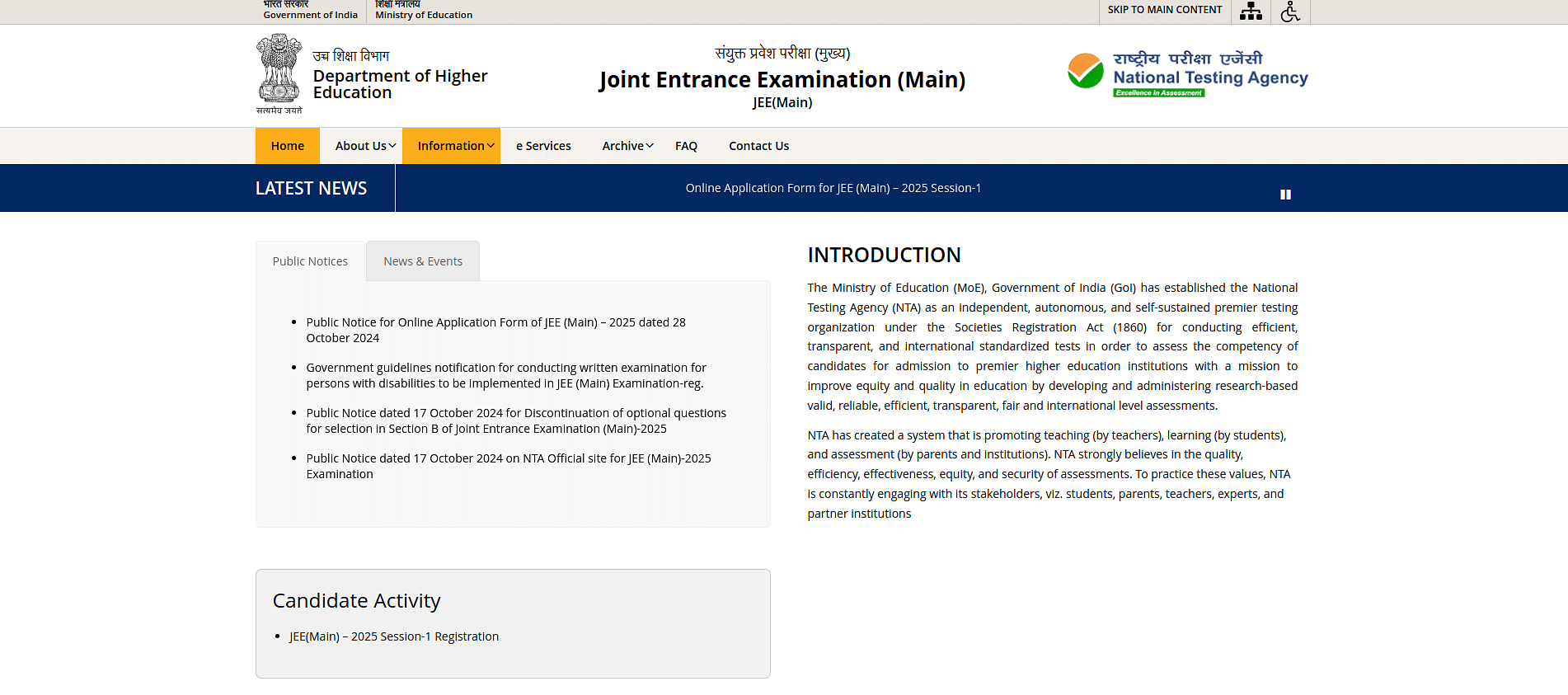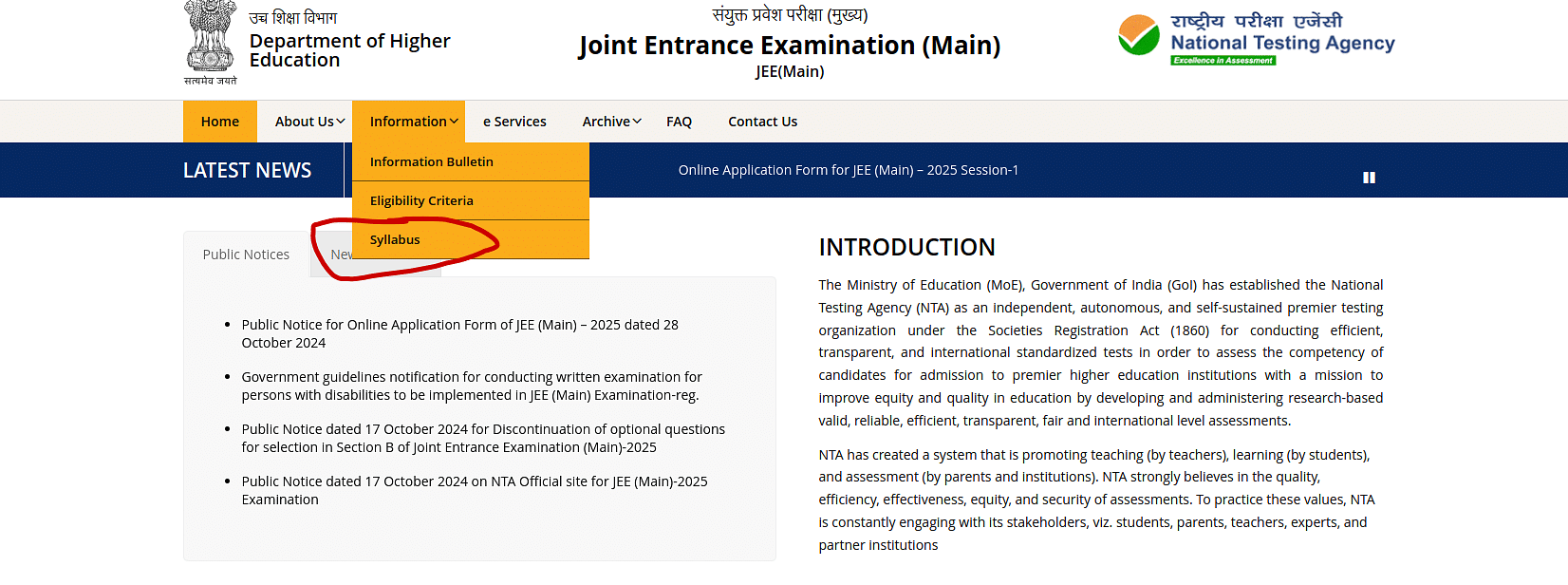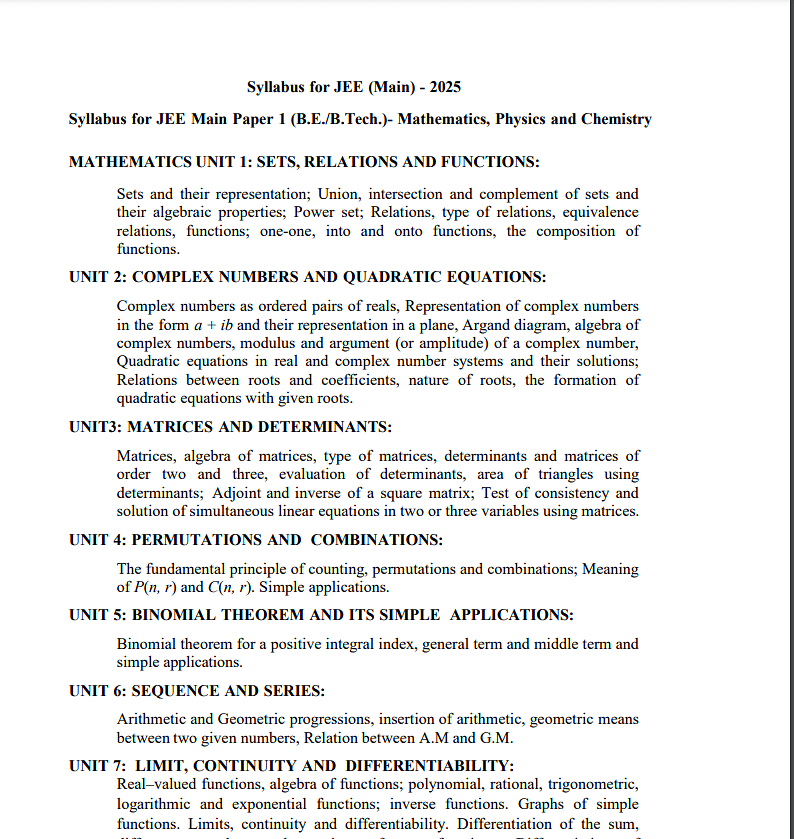JEE Main Session 2 Mathematics Syllabus
The JEE Main Mathematics Syllabus comprises 2 sections A and B, where section A consists of MCQs, and Section B comprises Numerical Value Questions. Section A contains negative markings. Candidates can check the mathematics syllabus here from the below table.
Unit 1: Sets, Relations and Functions
The Unit 1 of JEE Main Maths syllabus comprises topics from chapter Sets, Relations and Functions. Check the detailed JEE Mains Maths syllabus for Unit 1 below:
- Sets and their Representation: Union, Intersection and Complement of Sets and their Algebraic Properties
- Power Set
- Relation, Type of Relations, Equivalence Relations, Functions
- One-One, Into and Onto Functions
- The composition of functions
Unit 2: Complex Numbers and Quadratic Equations
The Unit 2 of JEE Main Maths syllabus comprises topics from Chapter Complex Number and Quadratic Equation. Check the detailed JEE Mains Maths syllabus for Unit 2 below:
- Complex Numbers as ordered pairs of Reals
- Representation of Complex Numbers in the form a + ib and their representation in a Plane
- Argand Diagram
- Algebra of Complex Number
- Modulus and Argument (or amplitude) of a Complex Number
- Square root of a Complex Number\
- Triangle Inequality
- Quadratic Equations in Real and Complex Number System and their solutions
- Relations between roots and coefficients, nature of roots, the formation of quadratic equations with given roots.
Unit 3: Matrices and Determinants
The Unit 3 of the JEE Main Maths syllabus comprises topics from Chapter Matrices and Determinants. Check the detailed JEE Mains Maths syllabus for Unit 3 below:
- Matrices
- Algebra of Matrices
- Type of Matrices
- Determinants and Matrices of Order Two and Three
- Properties of Determinants
- Evaluation of Determinants
- Area of Triangles using Determinants
- Adjoint and Evaluation of Inverse of a Square Matrix using Determinants and Elementary Transformations
- Test of Consistency and Solution of Smultaneous Linear Equations in Two or Three variables using Determinants and Matrices
Unit 4: Permutation and Combination
The Unit 4 of the JEE Main Maths syllabus comprises topics from Chapter Permutation and Combinations. Check the detailed JEE Mains Maths syllabus for Unit 4 below:
- The Fundamental Principle of Counting
- Permutation as an Arrangement and Combination as Section
- Meaning of P (n,r) and C (n,r)
- Simple applications
Unit 5: Binomial Theorem and its Simple Applications
The Unit 5 of the JEE Main Maths syllabus comprises topics from Chapter Binomial Theorem and its Simple Applications. Check the detailed JEE Mains Maths syllabus for Unit 5 below:
- Binomial Theorem for a Positive Integral Index
- General Term and Middle Term
- Properties of Binomial Coefficients
- Simple Applications
Unit 6: Sequence and Series
The Unit 6 of the JEE Main Maths syllabus comprises topics from Chapter Sequence and Series. Check the detailed JEE Mains Maths syllabus for Unit 6 below:
- Arithmetic and Geometric Progressions
- Insertion of Arithmetic
- Geometric means between two given numbers
- Relation between A.M and G.M sum up to n terms of special series
- Sn, Sn2, Sn3
- Arithmetico-Geometric Progression
Unit 7: Limit, Continuity and Differentiability
The Unit 7 of the JEE Main Maths syllabus comprises topics from Chapter Limit, Continuity, and Differentiability. Check the detailed JEE Mains Maths syllabus for Unit 7 below:
- Real–valued functions
- Algebra of Functions
- Polynomials
- Rational
- Trigonometric
- Logarithmic and Exponential Functions
- Inverse Function
- Graphs of Simple Functions
- Limits, Continuity, and Differentiability
- Differentiation of the Sum, Difference, Product, and Quotient of Two Functions
- Differentiation of Trigonometric
- Inverse Trigonometric
- Logarithmic
- Exponential
- Composite and Implicit Functions
- Derivatives of Order up to Two
- Rolle’s and Lagrange’s Mean Value Theorems
- Applications of Derivatives: Rate of change of quantities, monotonic Increasing and decreasing functions
- Maxima and Minima of Functions of One Variable, Tangents, and Normal
Unit 8: Integral Calculus
The Unit 8 of the JEE Main Maths syllabus comprises topics from Chapter Integral Calculus. Check the detailed JEE Mains Maths syllabus for Unit 8 below:
- Integral as an Anti-Derivative
- Fundamental Integrals Involving Algebraic, Trigonometric, Exponential, and Logarithms Functions
- Integrations by substitution, by parts, and by partial functions
- Integration using trigonometric identities
- Integral as limit of a sum
- The fundamental theorem of calculus, properties of definite integrals
- Evaluation of definite integrals, determining areas of the regions bounded by simple curves in standard form
Unit 9: Differential Equations
The Unit 9 of the JEE Main Maths syllabus comprises topics from Chapter Differential Equations. Check the detailed JEE Mains Maths syllabus for Unit 9 below:
- Ordinary Differential Equations, their order, and degree
- The formation of differential equations
- Solution of differential equation by the method of separation of variables, solution of a homogeneous and linear differential equation
Unit 10: Coordinate Geometry
The Unit 10 of the JEE Main Maths syllabus comprises topics from Chapter Coordinate Geometry. Check the detailed JEE Mains Maths syllabus for Unit 10 below
- Cartesian system of rectangular coordinates in a plane, distance formula, sections formula, locus, and its equation, translation of axes, the slope of a line, parallel and perpendicular lines, intercepts of a line on the co-ordinate axis.
Straight line
- Various forms of equations of a line, intersection of lines, angles between two lines, conditions for concurrence of three lines, the distance of a point form a line, equations of internal and external by sectors of angles between two lines co-ordinate of the centroid, orthocentre, and circumcentre of a triangle, equation of the family of lines passing through the point of intersection of two lines.
Circle, conic sections
- A standard form of equations of a circle, the general form of the equation of a circle, its radius and central, equation of a circle when the endpoints of a diameter are given, points of intersection of a line and a circle with the centre at the origin and condition for a line to be tangent to a circle, equation of the tangent, sections of conics, equations of conic sections (parabola, ellipse, and hyperbola) in standard forms, condition for Y = mx +c to be a tangent and point (s) of tangency
Unit 11: Three Dimensional Geometry
The Unit 11 of the JEE Main Maths syllabus comprises topics from Chapter Three Dimensional Geometry. Check the detailed JEE Mains Maths syllabus for Unit 11 below:
- Coordinates of a point in Space
- The distance between two points
- Section Formula
- Direction Ratios, and Direction Cosines,
- The angle between two intersecting lines
- Skew lines
- The shortest distance between them, and its equation
- Equations of a line and a plane in different forms
- The intersection of a line and a plane, and coplanar lines
Unit 12: Vector Algebra
The Unit 12 of the JEE Main Maths syllabus comprises topics from Chapter Vector Algebra. Check the detailed JEE Mains Maths syllabus for Unit 12 below:
- Vectors and Scalars
- The Addition of Vectors
- Components of a Vector in Two Dimensions and Three-Dimensional Space, Scalar and Vector Products, Scalar and Vector Triple Product
Unit 13: Statistics and Probability
The Unit 13 of the JEE Main Maths syllabus comprises topics from Chapter Statistics and Probability. Check the detailed JEE Mains Maths syllabus for Unit 13 below:
- Measures of Discretion
- Calculation of Mean, Median, Mode of grouped and ungrouped data
- Calculation of standard deviation, variance and mean deviation for grouped and ungrouped data
- Probability: Probability of an event, addition and multiplication theorems of probability, Baye’s theorem, Probability distribution of a random variate, Bernoulli trials, and binomial distribution
Unit 14: Trigonometry
The Unit 14 of the JEE Main Maths syllabus comprises topics from Chapter Trigonometry. Check the detailed JEE Mains Maths syllabus for Unit 14 below:
- Trigonometrical Identities and Equations
- Trigonometrical Functions
- Inverse Trigonometrical functions and their properties, heights, and distance
Related Questions
Q: Will functional equations be asked in the JEE Main 2025 exam?
A: Yes, functional equations are one of the important topics for the JEE Main Maths syllabus. The question from the functional equations is asked frequently in the JEE exam. In the previous session, 2 questions were asked in the JEE Main exam.
Q: Is the solution of triangles studied for the JEE Main exam?
A: No, the solution of triangles is part of the JEE Advanced syllabus; it is not needed to study for the JEE Mains exam. However, if you want to prepare for the JEE Advanced 2025, you have to go through the solution of triangles.















